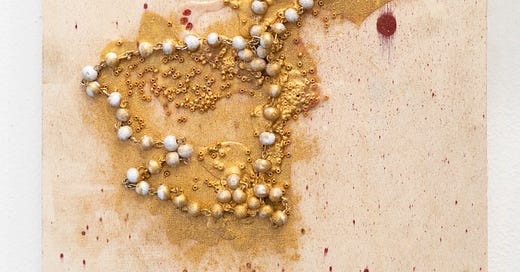The Lady of All Nations 2022
8x10
Rosary, decorative beads, dry pigment, spray paint, liquid adhesive, birch panel board
The Lady of All Nations is an apparition of the Virgin Mary which was witnessed during World War II by a woman named Ida Peederman in Amsterdam. She continued to appear to Peederman intermittently until 1984. The apparition’s most consistent message was that, even though she (the apparition) was Mary, she no longer wanted to be addressed by that name. Her new name was “The Lady of All Nations”, which implied that she was now something more than Mary, that the scope of her meaning included all people, not just Christians. I interpret this to mean that she was claiming identity with the great goddesses of compassion in the Sino-Vedic complex as well, especially Avalokitesvara and Quan Yin, who are often casually associated with Mary. Her additional message was that she was now to be recognized as co-redeemer with Christ himself (as “co-redemptrix”, and not just as “mediatrix”, the more traditional role whereby our prayers to Mary are passed on to Jesus through her). The sacred painting in her shrine in Amsterdam (which I visited on Holy Saturday this year on the way to Tilburg right before preparations for our Origin of the Alimonies performance began) features a woman in front of a cross, standing on a globe, radiating light rays downwards out of stigmata wounds in her hands towards a layer of clouds at her feet which, on second glance, reveal themselves to be a sea of sheep.
It was towards the beginning of these apparitions - in 1950 - that Pope Pius XII declared Mary’s assumption (the claim that Mary ascended into heaven after Jesus did, and did not die a human death) to be an official dogma of the Catholic Church. This was the first time in hundreds of years that the Pope used his authority to declare something a dogma (meaning unquestionably true, spoken directly by God through the pope; the pope has the power to do this, but he rarely exercises it); this was a major Marian event, along with the Fatima apparitions and the controversy surrounding her Third Secret. Pius XII was a passionate follower Mary; he also consecrated the whole world to her Immaculate Heart in 1942.
The Lady of All Nations is less well known than many other Marian apparitions and events. The veracity of the Amsterdam apparitions themselves is controversial in the Church, not recognized with the same status as that of Fatima or Pompeii, both of which this exhibition also addresses. The church allows The Lady to be worshipped privately (in other words, it doesn’t prohibit it), but doesn’t directly affirm that she’s an authentic apparition.
There are very specific criteria that the Church looks for in its efforts to distinguish authentic apparitions from false ones. This has been an interest and concern of my own ever since my relationship to Christianity became more dogmatic - how to distinguish, within the spiritual realm, between good and evil, between true and false? From the perspective of secular humanism, this question seems meaningless, with the result that any spirituality at all, or even any poetry at all, any super-rational drive or lurid quasi-illegibility is situated on one pole, opposed to the rational, the material, the ‘ordinary’ on the other. The former is more or less subsumed under the psychoanalytic concept of the dream. But from a Christian perspective, it’s crucial to distinguish between the authentically spiritual and the many, many forms of heresy that compete with it - in many ways this distinction is the founding gesture and ongoing engine of Abrahamic faith (‘worship only me, not other Gods’ etc).1
At the same time, authentic spiritual developments have consistently first appeared heretical to the church - the work of Aquinas and Eckhart stand out as the most well-known exemplars of this, same with Balthasar. Artistic originality is deeply connected to theology, and great theologians cross thresholds and defy norms just like artists, scientists and other visionaries do in the more obvious secular humanist context. But in both cases, it’s never completely clear what the value of originality really is, whether in the last instance, the real engine is always Capital, tending towards deterritorialization in every case, wearing whatever mask.2
The difficulty is similar to that involved in establishing truth in the realm of the Kantian transcendental, where there’s no stable criterion for truth since the realm is neither subjective nor objective, but in the theological instance scripture (the Bible) is taken as an authentic source for God’s words, with both aids in the effort and complicates it greatly. See the work of Avery Dulles and Hans Urs von Balthazar
But there’s no reason to assume that Capital really is always the engine in the last instance, unless you’ve made a philosophical decision about its status as metaphysical absolute (which would be a groundless decision, since its pertains to the Kantian transcendental just discussed). Materialists have a difficult time seeing that just because this idea is interesting, counterintuitive and difficult to understand, doesn’t mean it’s true




